Analysis
Why Is Art Star Ellsworth Kelly’s Auction Market So Low-Key?
We spoke to a number of industry experts to find out.
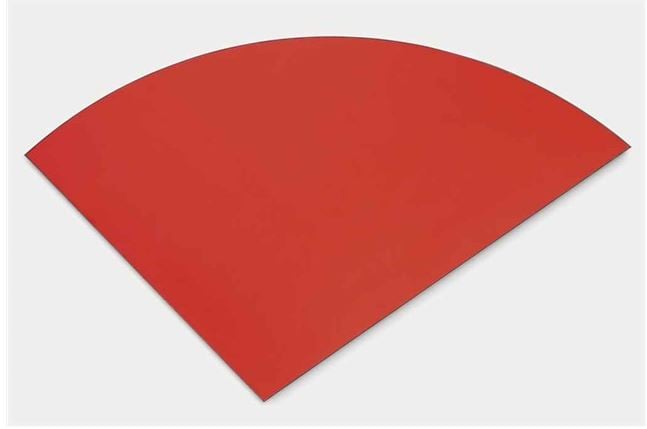
We spoke to a number of industry experts to find out.

Eileen Kinsella

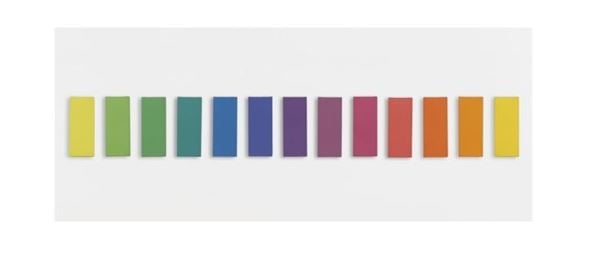
Ellsworth Kelly Spectrum VI (in 13 parts) (1969) is the highest selling work at auction to date. It sold for $5.2 million in 2007.
Ellsworth Kelly, who passed away in late December at the age of 92, is one of the most revered American artists of his generation. His hard-edge Color Field painting has drawn legions of fans over the years, and social media was immediately awash with tributes to the artist, his work, and his enduring influence.
Nevertheless, while demand for Kelly’s work has long been intense, auction activity is surprisingly subdued, especially when compared with the type of prices and volume seen for other esteemed contemporary American artists such as Jasper Johns and Robert Rauschenberg.
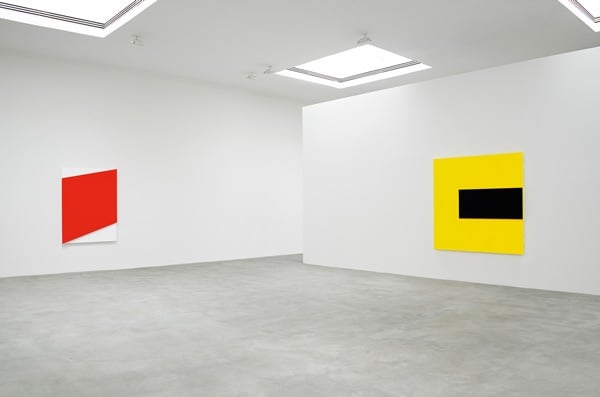
Installation of Ellsworth Kelly’s four-gallery exhibition at Matthew Marks, Chelsea, this past spring (May 12–June 20).
Photo: ©Ellsworth Kelly, Courtesy Matthew Marks Gallery.
Experts say it reflects the fact that the best of Kelly’s blue-chip works do not trade frequently—both on the primary market as well as at auction—with most having already been snapped up by institutions and prestigious private collections, where they tend to stay. In an era where even a hint of buzz can quickly push up the price of an emerging artist or send auction prices into the stratosphere for blue-chip legends, the steady track record of Kelly’s auction market stands out.
This “is one hundred percent due to the fact that Ellsworth himself cared most about who owns his paintings,” said Jacqueline Tran, senior director of Matthew Marks Gallery, which worked very closely with the artist in the last two decades of his life. The gallery’s first New York show in 1994 was a solo Kelly show. This past spring (May 12–June 20), Matthew Marks presented a four-gallery show of recent works by Kelly, all executed in 2013 and 2014, across its Chelsea spaces. On February 26, the gallery will present the first exhibition of Kelly’s photographs.
Kelly “placed enormous emphasis,” on where his works went, says Tran. “We, as his dealers, were taught that this was the most important issue—that museums and distinguished private collectors were given priority and the time to acquire the right work.” Tran said this extended to holding works on reserve for months or years, if necessary. Kelly “was very sensitive to the time it took for them to identify the right work for their collection and to raise the necessary funds.”
Tran adds: “It was his value system that set the stage. Collectors were extremely loyal. He had enormous curatorial and museum support internationally—curators knew that he valued their interest.”
Sara Friedlander, vice president and head of evening sale at Christie’s, was one of several art experts we spoke with who credited Matthew Marks with helping keep a tight lid on speculative buying through judicious oversight. Of the works themselves, Friedlander says they “fit so beautifully into any collection, whether they are interested in Minimalism, Color Field, Contemporary Art or the history of Postwar art. These are paintings that are so singular in their ability to attract a very wide variety of collectors. I think that’s one of the reasons why you don’t seem them come up so often. People just don’t want to part with them.”
Among US museums with the largest holdings of Kelly’s work are the Museum of Modern Art and the Art Institute of Chicago. Among European institutions, the Centre Pompidou has a significant number of his works, in addition to the Stedlijk Museum inAmsterdam, and the Tate in London.
In 2011 in Germany there two were separate shows of Kelly’s work on view concurrently: “Ellsworth Kelly Black and White,” a major retrospective of his black and white paintings, was at the Haus der Kunst, Munich (October 2011 – January 2012); and “Plant Drawings,” a major retrospective at Staatliche Graphische Sammlung, Pinakothek der Moderne, Munich (Oct 2011 – January 2012). The latter show traveled to the Louisiana Museum of Modern Art in Denmark, and Metropolitan Museum of Art in New York.
Meanwhile, the artnet Price database lists over 2,200 results for Kelly’s work. It is perhaps telling that the record—$5.193 million for the 1969 work Spectrum VI (in 13 parts) was set more than eight years ago, in November 2007, and has not been surpassed since. Tran says prices on the primary and private side are roughly “two-fold” that of the auction level.
“The market only tells one side of the story,” said Friedlander. “There hasn’t yet been a major breakout [in price] and there simply has not been anything major to come up.”
“Ellsworth Kelly’s work only occasionally comes to auction, and last night his ‘Spectrum VI,’ a group of 13 single-color canvases arranged in a horizontal row, was on offer,” wrote New York Times art reporter Carol Vogel in her 2007 report of the auction at which Kelly’s record was broken. “Three people went after it, and it sold for $4.6 million, or $5.1 million with commission, marginally above its low estimate. Still, it was a record price for the artist.”
Christie’s holds the record for the second highest price, set more recently, in May 2014, for the large 150-inch wide Red Curve V (1982). Noting that sale, Friedlander points out “the estimate of $1.8 million to $2.5 million was relatively conservative, and it sold for $4.4 million. It was so interesting to see that there was a great depth of bidding against the low end of the estimate.”

Ellsworth Kelly. Red Curve V (1982). sold for $4.5 million at Christie’s in May 2014.
Kelly’s work first broke the $1 million mark in 2000. Since then, more than two dozen of his works have sold for more than $1 million apiece at auction:
Top Prices at Auction for Ellsworth Kelly
Spectrum VI (in 13 parts) (1966) $5.2 Million
Red Curve V (1982) $4.5 Million
Chatham X: Black red (1971) $4.3 Million
Untitled (Totem) (1996) $4 Million
Red Over Yellow (1966) $3.97 Million
Untitled (1987-88) $3.8 Million
Black panel I (1985) $3.7 Million
Green white (1969) $3.55 Million
Orange Blue 1 (1964-65) $3.2 Million
Green Black (1968) $2.96 Million
Though he might have been hard to come by at auction, Kelly has been sought out in recent years for noteworthy commissions. This past winter, the Blanton Museum of Art at the University of Texas at Austin announced that it would build and acquire Kelly’s first-ever building on its grounds.
The stand-alone structure, Austin, will measure 73 by 60 feet and is meant to be “a space for contemplation,” according to a statement from the museum. The building will have 2,715 square-feet of space and will feature a totemic wooden sculpture, colored glass windows, and 14 black and white stone panels in marble, all designed by the artist. This project marks the first time that Kelly has ever worked with glass or marble. The school has undertaken a $23 million fund-raising campaign for the building.
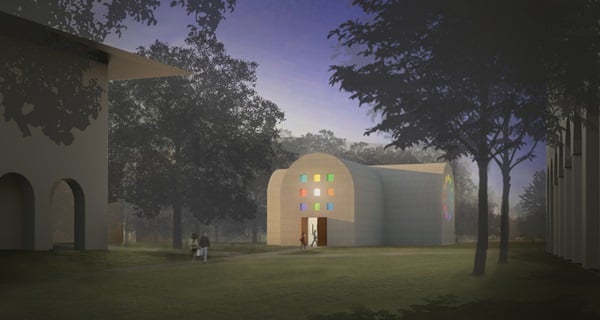
Ellsworth Kelly Austin (2015) (exterior rendering). Artist designed building with installation of colored glass windows, marble panels, and redwood totem. Photo: Courtesy the Blanton Museum of Art, Austin Texas.
In 2012 collector Leon Black commissioned site-specific work—large painted aluminum panels—for Dartmouth College’s Hopkins Center for the Arts. And in late November 2014, the Clark Art Institute opened an exhibition “Monet/Kelly” that focused on the major influence of Claude Monet on Kelly.
Los Angeles has also felt Kelly’s magnetic pull. When Chelsea gallerist Matthew Marks opened a gallery space in Los Angeles, he commissioned Kelly to create the facade of the building, a work inspired by two famous 1960s works, Study for Black and White Panels, a collage, and a painting Black Over White. It was a way of bringing things full circle for Marks, given the gallery’s 1994 inaugural Kelly show in New York.
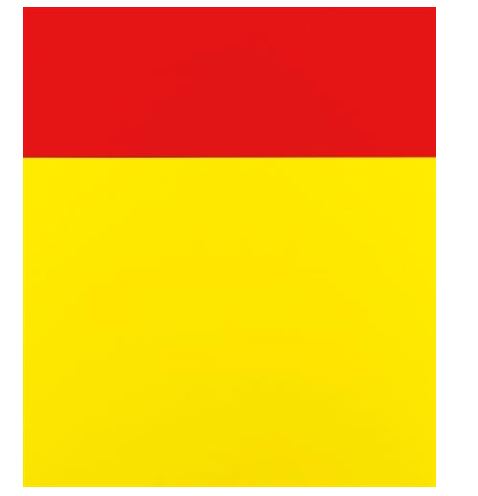
Ellsworth Kelly Red Over Yellow (1966) sold for $3.97 million at Sotheby’s in May 2013.
Among other top-selling works at auction are Chatham X Black Red, (1971) that sold for $4.3 million at Sotheby’s in 2011, a sculpture, Untitled (Totem), dated 1996, that sold for $4 million at Sotheby’s in 2010, and Red Over Yellow, two attached canvases, (1966) for just under $4 million, at Sotheby’s in May 2013.

Ellsworth Kelly
Photo: artnewengland.com
Tran says the artist “cared more about works enduring in the public eye rather than comprising in order to get the highest prices. And I think that’s what built his reputation and why there is enormous respect.”